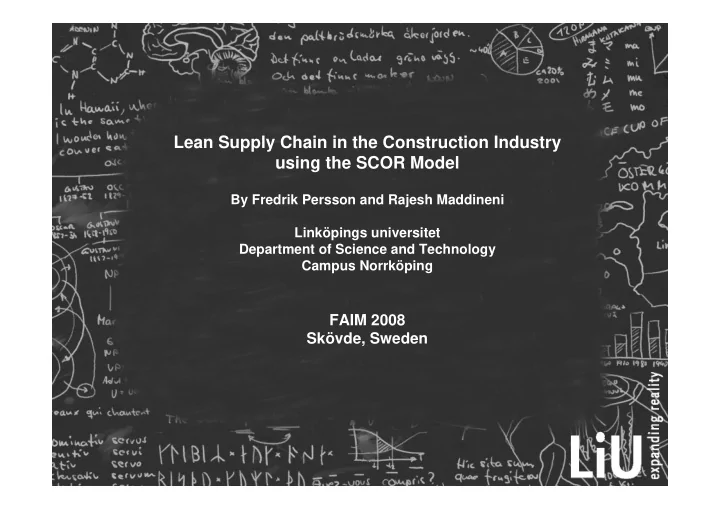

Lean Supply Chain in the Construction Industry using the SCOR Model By Fredrik Persson and Rajesh Maddineni Linköpings universitet Department of Science and Technology Campus Norrköping FAIM 2008 Skövde, Sweden
Content • Research idea • The SCOR Model • Lean Supply Chain • Extended SCOR Model • The Construction Industry • A Case Study • Conclusions and Outlook
Research idea • The SCOR model is a useful tool when improving operations in a supply chain (Supply Chain Operations Reference Model) • Improving operations is today (for some companies) equal with Lean initiatives • Question? - What in the SCOR model can be considered Lean or Agile? - How can that information be used? • Answer: - A list of Lean and Agile: Best practices, metrics, and process characteristics - A case study from the construction industry
The SCOR Model – Level 1 Supply Chain Operations Reference Model P S M D P P R R S M D S M D R R R R P S M D Level 1 R R Source: SCOR 8.0
The SCOR Model – Level 2 Plan Suppliers Company A Distribution Source ”make to stock” products P2 P3 P4 Supplier 1 M1 D1 S1 Supplier 2 M2 D2 S2 M2 D2 S2 D2 M3 D3 S3 Supplier 3 Return excess product DR3 SR3 DR3 SR3 DR1 SR1 DR1 SR1 Return defective product Source ”make to order” products Make to order Deliver ”make to order” products Source ”engineer to order” products • Directive #1 : Focus on the SCOR Model Level 2 Source: SCOR 8.0
Source: SCOR 8.0 SCOR - Processes
Source: SCOR 8.0 SCOR – Best Practices (M1)
Source: SCOR 8.0 SCOR – Metrics
Lean Supply Chain • Lean Supply Chain is a Supply Chain based on Lean principles - Eliminating waste - Short lead times - Small batch size - Low inventories, etc. • Lean is production and transportation at low costs • Agile is production and transportation to meet customer demands • The Customer Order Decoupling Point often separate the two • Directive #2 : Focus both on Lean and on Agile initiatives
Extended SCOR Model Extended with Lean principles Agile 1. Quality 1. Service Level 2. Cost 3. Lead Time Lean 1. Quality 1. Cost 2. Cost 3. Service Level Market Qualifiers Market Winners Source: Mason-Jones et al. 2000
Extended SCOR Model Process element Lean characteristics Agile characteristics S1 - Less time and cost for scheduling. - Multiple sourcing options. Source make-to-stock - Less days for engineering and - Flexible lead times. S2 schedule changes. Source make-to-order - Deliveries according to the project S3 scheduling. Source engineer-to-order - Maximum percentage of orders/lines completed. - Direct shipment to project site may reduce costs and time delays. - Maximum orders/lines received in time. - Less cost and time for verifying products. - Maximum percentage of products transferred on time. - Maximum fill rate and maximum inventory days of supply. - Less returns and transaction errors. - Less time for supplier selection.(ETO) - Faster negotiations and selecting good suppliers. (ETO)
Construction Industry • The Construction Industry in Sweden - 60.000 companies - EUR 32 Billion turnover - 450.000 employees Product structure & Product life cycle stages I. Low volume, II. Multiple III. Few major IV. High volume, low products, low products, higher high standardisation, volume volume standardisation, one of a kind commodities Process structure & Process life cycle stages I. Firm position II. Jumbled flow (job shop) III. Disconnected line flow (batch) IV. Connected line flow (assembly line) V. Continuous flow
The Case Study • The generic supply chain for Peab (AS IS) Peab M1 D1 S1 M2 D2 S2 M3 D3 Construction site M3 D3 S3 S1 D1
The Case Study Process element Lean possibility − Sourcing should be done according to the sourcing plans of S2, S3. S1, S2, S3 − Maximum orders received in time. − Fewer errors in products received. − Maximum fill rate. − Orders should arrive simultaneously. − Multiple suppliers for emergency requirements − Produced depending on Demand for M3 at construction site. M1, M2, M3 − Less defects. − Less Engineering Changes (M2, M3). − Lot Purchasing is appreciable. S1 − Selected so that can be for multiple projects. − Scheduled according to the demand at construction site. M3(at PEAB) − Less defects. − Less engineering changes results in less changes in machinery setups. − Producing at a time for the whole demand for the construction site is appreciable. − Minimal delivery errors in case of M1. D1, D2, D3 − Less costs for delivery. − Merge in transit is better solution.
Conclusions • This paper has introduced the concept of lean principles into the SCOR model. - The lean principles are already part of the SCOR model but are here identified and listed. - Facilitate the implementation of lean principles in a supply chain. • The SCOR model contain standardized processes • To use the SCOR model is to introduce standardized processes in a supply chain for the opportunity of lean supply chain.
Thank you! This research is sponsored by Brains & Bricks. In Brains & Bricks, Linköping University cooperates with Peab and the local authorities in the Katrineholm area. www.liu.se/b2
Recommend
More recommend